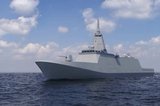ONR studies high-speed planing hulls
The US Office of Naval Research (ONR) has sponsored work to look into the wave-generated pressure, forces and motions faced by boats with high-speed planing hulls, it announced on 27 May.
Planing hulls produce lift and allow watercraft to glide over water to achieve higher speeds; but high wave crests result in the boat rising to the top of the wave and then falling to the trough at great force, called a 'wave slam'.
The research conducted by ONR aims at identifying ways to save weight on the hull in order to carry greater loads without sacrificing speed capabilities.
Bob Brizzolara, program officer, sea warfare and weapons department, ONR, said: 'When a hull is going at speed and it hits a wave, it's like hitting a wall - it's a violent collision, and the forces are very large. This causes injuries to sailors - commonly back and leg injuries - and also can degrade the structure of the vessel.'
Carolyn Judge, associate professor, naval architecture and ocean engineering department, US Naval Academy (USNA), said: 'To deal with the effects of wave slams, the navy must have strong boats that are forced to reduce speed in higher seas. Mitigating the problem of wave slams will allow navy boats to travel faster in higher seas states as well as allow for lighter boat structural designs.'
ONR is working with the University of Iowa and the USNA's Naval Surface Warfare Center (NSWC), Carderock Division, to consider hull weight reduction options. The research is being executed by experimenting with scale models tested at NSWC Carderock's tow tank and with computer simulations developed by the University of Iowa.
More from Naval Warfare
-
![NATO tests use of “undetectable, jam-proof” laser communication in maritime scenarios]()
NATO tests use of “undetectable, jam-proof” laser communication in maritime scenarios
As part of its effort to better prepare its capabilities for operations in contested and congested scenarios, NATO evaluated a Lithuanian ship-to-ship terminal designed to not be susceptible to enemy interference.
-
![Future of the Canadian Patrol Submarine Project is still unclear]()
Future of the Canadian Patrol Submarine Project is still unclear
The Canadian government remains tight-lipped on the timeline and funding required for the next steps of its Canadian Submarine Patrol Project, which should offer improved capabilities for the country’s navy.
-
![Mitsubishi eyes future with Australia’s Mogami selection]()
Mitsubishi eyes future with Australia’s Mogami selection
With Australia’s selection of the Mogami-class for Project Sea 3000, Mitsubishi is investigating local production in the next decade as potential export opportunities emerge.
-
![Thales’ new Sonar 76Nano could equip UK Royal Navy on anti-submarine warfare missions]()
Thales’ new Sonar 76Nano could equip UK Royal Navy on anti-submarine warfare missions
The new sonar is designed to equip uncrewed underwater vessels, with the potential to be used by the Royal Navy for its Atlantic Bastion and Atlantic Net missions.























